The Homer IPTs
No Reasonable Offer Refused
I hate sailing with a less than full boat. If you would like to make a low-ball offer on one or more of the Bald Eagle IPTs below, please click here.
IPT #1: MON 20 FEB 2023 through the full day on FRI 24 FEB 2023. Five full days/20 hours on the boat: $5500.00. Limit 5 photographers/Openings: 1.
IPT #2: SAT 25 FEB 2023 through the full day on THURS 2 MAR 2023. Six full days/24 hours on the boat: $6600.00. Limit 5 photographers/Openings: 3.
IPT #3: FRI 3 MAR 2023 through the full day on TUES 7 MAR 2023. Five full days/20 hours on the boat: $5500.00. Limit 5 photographers. Openings: 1.
Rooms at Lands End Resort are available for all of the dates above.
What’s Up?
Though I was feeling a bit better, I skipped my swim again on Monday. And again, I got lots accomplished, especially on my 2022 taxes. I was glad to learn that Andrew Schonbek will be signing up for DeSoto #3. May is a wonderful time to be at DeSoto. But heck, so are March and April!
I could not choose a favorite from yesterday’s three running shorebird images as all were sharp, perfectly exposed, and nicely designed. And I loved the backgrounds.
Though several folks answered the “why crouching?” question, nobody struck paydirt. I was, of course, crouching to reduce the angle of declination to the bird (to get lower). The reason that crouching was better than sitting is that I was easily able to get ahead of sun angle and let the birds run towards me. Like the birds, I was constantly on the move to stay on sun angle. I simply could not get up and down quickly enough to do that. For the same reason, the 200-600 was a much better tool for the job than the 600 with or without a tripod. The 2-6 is lighter and much more manageable than fixed lens. The Sanderling needed less light because the whites are much brighter white than on the other two species. Learn all of the above and tons more by joining me on a DeSoto IPT this spring.
Today is Tuesday 31 January 2023. I will continue to work on my 2022 taxes and catch up on e-mails. This blog post took about 90 minutes to prepare (including the time spent on the two image optimizations) and makes three hundred-eight days in a row with a new, educational post. Wherever you are and whatever you are doing, I hope that you too have a great day.
Please, please, pretty please remember to use my B&H or Bedford’s affiliate programs for all your new gear purchases.
The plan is to continue to post every day until the streak reaches one year and one day and then go back to posting every other day.
Please remember to use the B&H and Amazon links that are found on most blog pages and to use the BIRDSASART discount code at checkout when purchasing your new gear from Bedfords to get 3% back on your credit card and enjoy free second-day air FedEx. Please, also, consider joining a BAA IPT. You will be amazed at how much you will learn!
You can find some great photo accessories (and necessities, like surf booties!) on Amazon by clicking on the Stuff tab on the orange/yellow menu bar above. On a related note, it would be extremely helpful if blog-folks who, like me, spend too much money on Amazon, would get in the habit of clicking on the Amazon logo link on the right side of each blog post when they shop online. As you might expect, doing so will not cost you a single penny, but would be appreciated tremendously by yours truly. And doing so, works seamlessly with your Amazon Prime account.
Please remember that if an item — a Delkin flash card, or a tripod head — for example, that is available from B&H and/or Bedfords, is also available in the BAA Online Store, it would be great, and greatly appreciated, if you would opt to purchase from us. We will match any price. Please remember also to use my B&H affiliate links or to earn 3% cash back at Bedfords by using the BIRDSASART discount code at checkout for your major gear purchases. Doing either often earns you free guides and/or discounts. And always earns my great appreciation.
|
|
|
This image was created on 28 April on a Spring 2022 Fort DeSoto Park IPT. Standing, I used the handheld Sony FE 200-600mm f/5.6-6.3 G OSS lens (at 600mm) and The One, the Sony Alpha 1 Mirrorless digital camera. ) The exposure was determined using Zebra technology with ISO on the Thumb Dial. ISO 800. 1/3200 second at f/6.3 (wide-open) in Manual Mode. AWB at 6:32:37pm on a sunny afternoon. RawDigger showed the exposure to be dead-solid perfect. Tracking: Zone AF-C with Bird Face/Eye Detection performed perfectly. Be sure to click on the image to enjoy a high-res version. Image #1: Tricolored Heron striding
|
Understanding the Angle of Declination
This image was created while I was standing, and possibly crouching just a bit. The angle of declination, the degree to which the lens was pointing down at the subject, was much greater than the angle of declination with Image #2 where I was seated, perhaps only slightly above the level of the bird. The greater the angle of declination, the more detail you will see in the (more proximate) background. As you get lower and lower, the distance from the subject to the background is increased thus throwing the background more out of focus (as long as the aperture remains relatively constant).
|
|
|
This image was also created on 28 April on a Spring 2022 Fort DeSoto Park IPT. Seated on damp sand, I used the handheld Sony FE 200-600mm f/5.6-6.3 G OSS lens (at 600mm) and The One, the Sony Alpha 1 Mirrorless digital camera. ) The exposure was determined using Zebra technology with ISO on the Thumb Dial. ISO 800. 1/3200 second at f/6.3 (wide-open) in Manual Mode. AWB at 6:49:59pm on a sunny afternoon. RawDigger showed the exposure to be dead-solid perfect. Tracking: Zone AF-C with Bird Face/Eye Detection performed perfectly. Be sure to click on the image to enjoy a high-res version. Image #2: Tricolored Heron hunting
|
The Quality of Light
As the sun drops lower and lower in the sky on clear afternoons, the light becomes warmer and warmer each minute. Notice the difference in the quality of light in Image #1 as compared to Image #2 while considering that Image #2 was created less than 18 minutes after Image #1.
Image Questions
Which image do you like best? Why?
Which background do you like best? Why?
Which light do you like best? Why?
About how many degrees was the lens pointed down when I made Image #1?
About how many degrees was the lens pointed down when I created Image #2?
My thoughts tomorrow in the What’s Up? item.
|
|
|
Fort DeSoto in spring is rife with tame birds, many in full breeding plumage. Click on the composite to enjoy a larger version. Clockwise from upper left around to center: Laughing Gull landing on head of Brown Pelican, Laughing Gull in flight, Reddish Egret sunrise silhouette, Great Blue Heron with needlefish, Yellow-crowned Night Heron with ghost crab, Roseate Spoonbill, Sanderling in breeding plumage, and white morph Reddish Egret in glorious breeding plumage. |
The 2023 Spring Fort DeSoto Instructional Photo Tours (IPTs)
Spring Fort DeSoto IPT #1: Tuesday 28 March through the morning session on 31 March 2023. 3 1/2 Days: $1899.00 includes three working brunches. Limit six photographers.
Spring Fort DeSoto IPT #2: Tuesday 11 April through the morning session on 14 April 2023. 3 1/2 Days: $1899.00 includes three working brunches. Limit six photographers.
Spring Fort DeSoto IPT #3: Tuesday 9 May through the morning session on 12 May 2023. 3 1/2 Days: $1899.00 includes three working brunches. Limit six photographers.
Fort DeSoto, located just south of St. Petersburg, FL, is a mecca for terns and gulls, wading birds, and shorebirds in spring. Many of the birds will be in full breeding plumage. Simply put, DeSoto is the new Ding Darling. Migrant shorebirds are in abundance, and many are exceedingly tame. We should have great chances on Royal and Sandwich Terns and both white- and dark-morph Reddish Egrets. Great Egret, Snowy Egret, Great Blue Heron, Tricolored Heron, and White Ibis are easy as well and we will almost surely come up with a tame Yellow-crowned Night-Heron or two along with some American Oystercatchers. We will enjoy lots of great flight photography, especially with the Brown Pelicans.
|
|
|
Again, Fort DeSoto in spring is rife with tame birds, most in breeding plumage. Click on the composite to enjoy a larger version. Clockwise from upper left around to center: Laughing Gull in flight, Yellow-crowned Night-Heron, Sandwich Terns copulating, Roseate Spoonbill, Great Egret with reflection, breeding plumage Short-billed Dowitcher, American Oystercatcher, Royal Tern, white morph Reddish Egret, and Snowy Egret in marsh. |
In Addition!
We should also get to photograph a variety of other shorebirds including Black-bellied, Semipalmated, Wilson’s, Snowy, and Piping Plovers, Willet, Dunlin, Short-billed Dowitcher, Marbled Godwit, and most especially, Red Knot, with many individuals in their handsome breeding plumages. In spring the T-shaped peninsula and the newly formed sandbar, Outback Key, are literally packed with avian treasures.
With just a bit of luck, we may get to photograph one of Florida’s most desirable species: Roseate Spoonbill. And we will surely get to do some Brown Pelican flight photography. With luck, they will have Laughing Gulls landing on their heads. And though not guaranteed, Wood Stork might well be expected. And we will be on the lookout for a migrant passerine fallout in the event of a thunderstorm or two.
|
|
|
Yes, Fort DeSoto in spring is rife with tame birds, most in breeding plumage. Click on the composite to enjoy a larger version. Clockwise from upper left around to center: breeding plumage Dunlin, dark morph Reddish Egret displaying, Laughing Gull vertical front-end portrait, Laughing Gull with prey item, landing on head of Brown Pelican, breeding plumage Royal Tern displaying, Royal Terns — pre-copulatory stance, Laughing Gulls copulating, Laughing Gull head portrait, breeding plumage Sandwich Tern with fish, and a rare treat, a breeding plumage White-rumped Sandpiper. |
What You Will Learn on a DeSoto IPT
- 1- The basics and fine points of digital exposure; how to get the right exposure every time after making a single test exposure (or before if you are using SONY gear).
- 2- How and why to work in Manual mode (even if you’re scared of it).
- 3- How to approach free and wild birds without disturbing them.
- 4- Lots about bird behavior and how to use that knowledge to help you create better images.
- 5- To age and identify many species of shorebirds including various sandpipers, plovers, dowitchers, and possibly yellowlegs.
- 6- To spot good situations and to choose the best perspective.
- 7- To see, evaluate, and understand the light.
- 8- To design pleasing images by mastering your camera’s AF system.
- 9- And perhaps most importantly, to evaluate wind and sky conditions and understand how they affect bird photography.
- 10- More than you could ever imagine.
|
|
|
You’ve got it by now! Fort DeSoto in spring is rife with tame birds, many in breeding plumage. Click on the composite to enjoy a larger version. Clockwise from upper left around to center: Roseate Spoonbill, immature Brown Pelican in flight, the heron/egret hybrid, American Oystercatcher feeding, immature Royal Tern on railing, Great Egret morning silhouette, Black Skimmer in surf, and underside head portrait of Great Blue Heron. |
The Details
Morning sessions will run two and one-half to three hours; afternoon sessions about two. There is never a set schedule on an IPT — we adapt to the conditions. On cloudy mornings with the right wind, we may opt to photograph till noon and skip the afternoon session. That especially when the afternoon weather is looking iffy. We may opt to visit a great North Tampa rookery if conditions warrant that.
There will be a Photoshop/Image Review session before and after brunch (included) each of the three full days. That will be followed by Instructor Nap Time. Each of these IPTs will run with only a single registrant as I do not like disappointing anyone. The best airport is Tampa (TPA). Once you register, you will receive an e-mail with lodging information. Do know that it is always best if IPT folks stay in the same general area (rather than at home or at a friend’s place a good distance away).
Folks attending this IPT will be out in the field as early as possible and stay out late to take advantage of sunrise and sunset colors; this is pretty much a staple on almost all BIRDS AS ART Instructional Photo-Tours. Doing so will often present unique photographic opportunities, opportunities that will be missed by those who need their beauty rest and those who need to get home for a proper dinner. I really love it when I am leaving the beach at 9:30am on a sunny morning after a great session just as a carful or two of well-rested photographers are arriving … We will be getting wet.
Your $599 deposit is due now. Credit cards are OK for that. You can register by calling Jim or Jennifer during weekday business hours at 863-692-0906 with a credit card in hand. Once you leave a deposit, you will receive an e-mail with your balance statement and instructions for sending your balance check three months before the trip begins. If you wish to pay in full right off the bat, you can make your check out to BIRDS AS ART and send it via US mail here: BIRDS AS ART, PO BOX 7245, Indian Lake Estates, FL 33855. You will receive a confirmation e-mail with detailed instructions, and clothing and gear advice two months before the trip. Please shoot me an e-mail if you plan to register or if you have any questions.
IPT veterans and couples or friends signing up together may e-mail for discount information.
Typos
With all blog posts, feel free to e-mail or to leave a comment regarding any typos or errors.

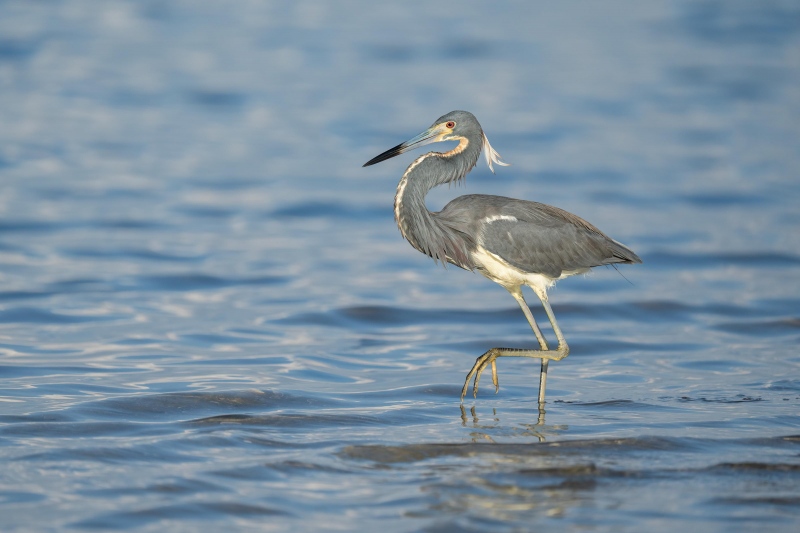
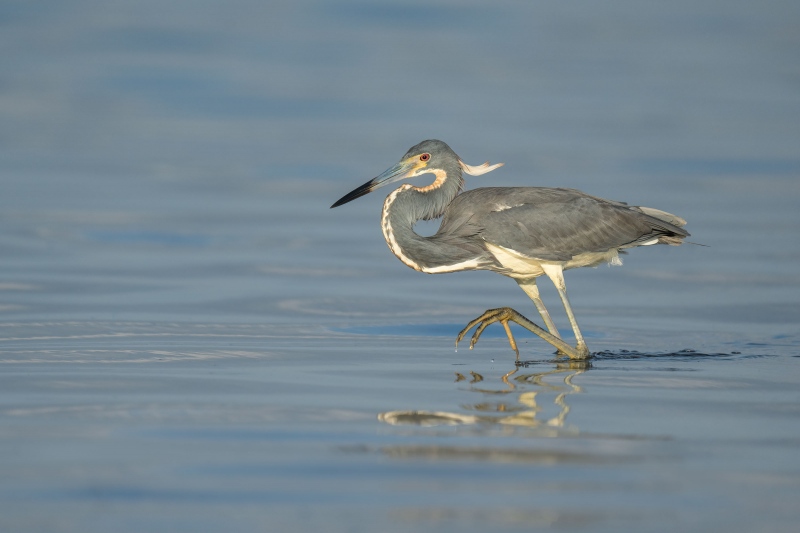
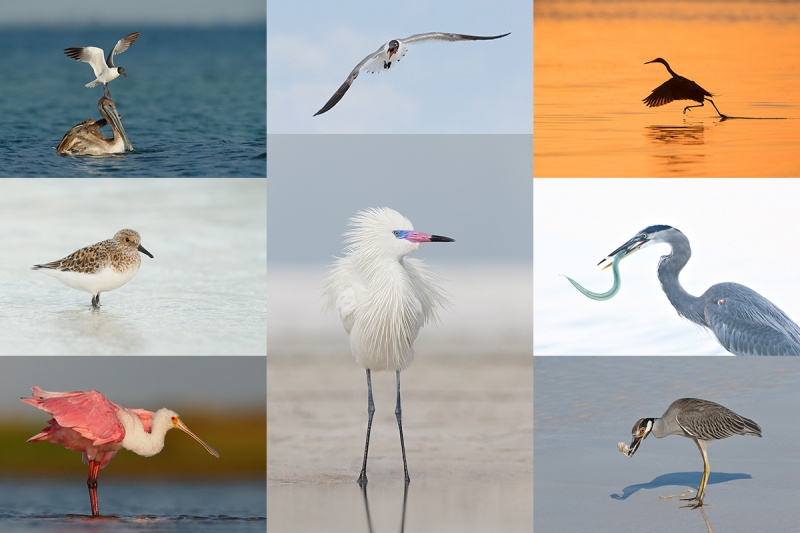
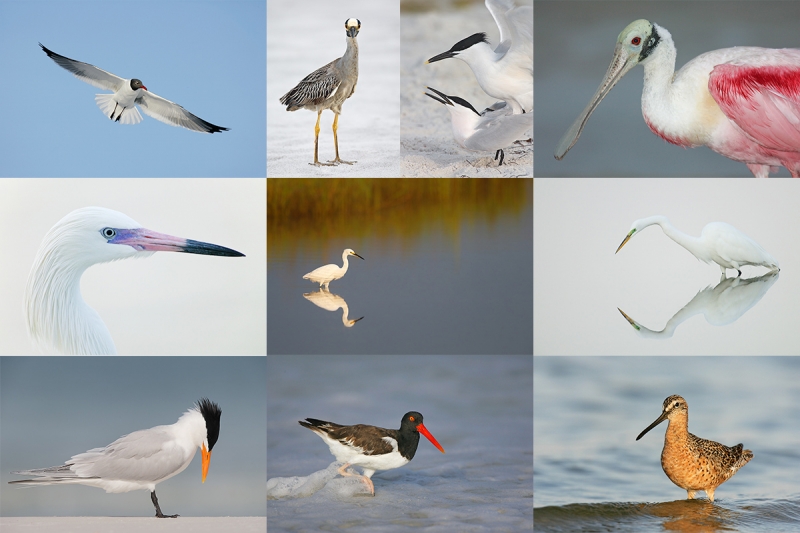
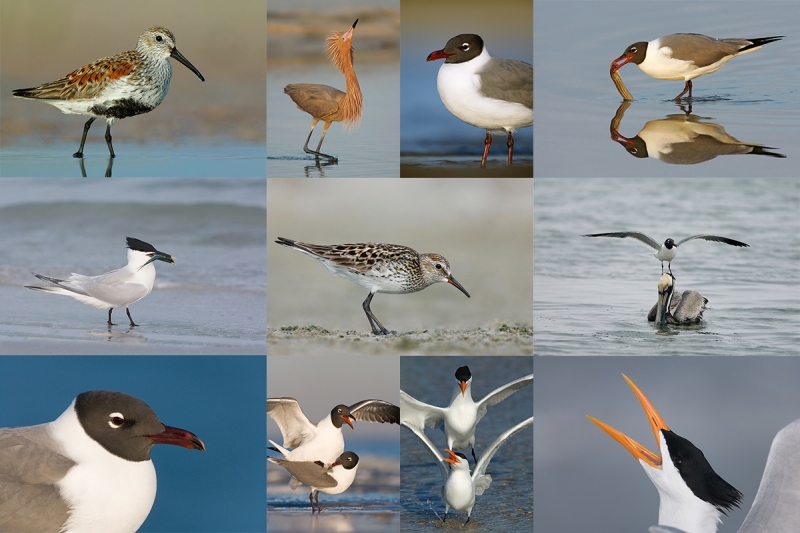
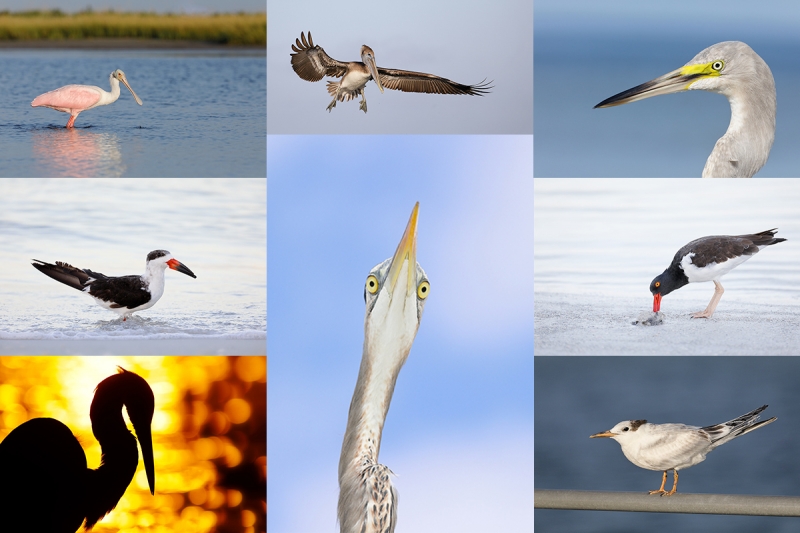













#1 & #1 & #1. I like the pose, the color of the water and sweet beauty of this bird. You got lower for the #2 pic which blurred the water and deadened the crispness of the water color and in effect darkened the back ground. Both shots are great, but to my eye #1 takes it and reminds my minds eye of what I see when I’m fortunate to get out there. I’m really missing the peace and quiet and sort of meditative time with nature. So easy on the brain and soothing to the senses.
I like #2 better by far because of the smoother background where you were low. Also because of the warmer light, the patchy reflection and the bird a bit larger in the frame.
Both two images of Tricolored Heron striding and hunting are interesting and well made. I enjoyed looking at these two images today.
Artie
I do like both images as the first has a nice look of the water but in the second it seems more dreamy and i like that. He looks coiled up ready to strike and i love the water droplets falling from the toes.
I have no idea on the angle of declination to be honest, i have a hard enough time to get on the right sun angle and mostly due to areas i may not be able to if on the river in areas of cliffs or just where the sun may be. “When” i get one right to my eye i do an ooh baby dance 🙂 I’d love to get more right so i keep trying.
Always with love b
Which image do you like best? Why?
#2 for the background
Which background do you like best? Why?
Again, #2 as I tend to prefer getting the background as distant as possible all things being equal.
Which light do you like best? Why?
I’m really neutral on this. The light/white balance is really subjective as it can be processed naturally or stoked one way or the other for the desired effect.
About how many degrees was the lens pointed down when I made Image #1?
~15°-20°
About how many degrees was the lens pointed down when I created Image #2?
I’d imagine less than 10°.
Not a clue re angle of declination!! Have to disagree with Don though, I much prefer image 1, less blur of course, and I much prefer the taller stance of the Heron…
Thanks. What blur are you talking about?
a
Background blurred.
Hello,
I like the second image the best, Love the white feathers standing out, and the slight yellow light on the heron. Just more pleasing to me.
Don Poggensee
N.W. Iowa
Thanks, Don. Is Iowa a new home for you?
with love, artie